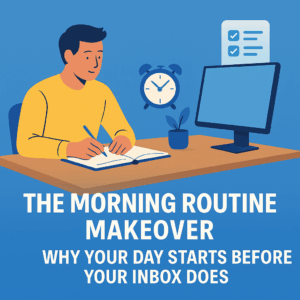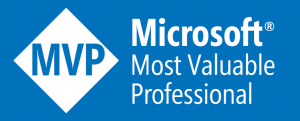Why Your Day Starts Before Your Inbox Does
I don’t know about you, but my morning routine needs a makeover. For many years I was up by 5:30 am and preparing for a “short” run of 5 to 7 miles, but my operating system no longer recognizes that application. Some people swear by meditation. Others swear at their inbox. But in the age of remote work, hybrid chaos, and 9 a.m. Teams all-hands calls that can sometimes feel more like midnight, there’s one undeniable truth: how you start your morning sets the tone for everything that follows. And no, checking email in bed doesn’t count as a routine. It counts as sabotage.
 We’ve built our digital work lives around tools: Microsoft 365, Teams, To-Do lists, dashboards, pings, nudges, reminders. But the tools are only as good as the habits behind them. Morning routines—those first 30 to 90 minutes—are the last bit of real estate we control before the demands of the day storm the gates. And for knowledge workers trying to stay sane and sharp, how we use that time can mean the difference between focus and flailing.
We’ve built our digital work lives around tools: Microsoft 365, Teams, To-Do lists, dashboards, pings, nudges, reminders. But the tools are only as good as the habits behind them. Morning routines—those first 30 to 90 minutes—are the last bit of real estate we control before the demands of the day storm the gates. And for knowledge workers trying to stay sane and sharp, how we use that time can mean the difference between focus and flailing.
Let’s be clear: this isn’t about waking up at 5:30 a.m., taking cold plunges, or journaling on a mountaintop. This is about designing a system that works for your brain, your role, and your reality. Whether you’re on a train to the office or padding down the hall to a makeshift home desk, the principle stands: intentional rituals beat reactive behavior every time.
Your Brain Before the Storm
Neuroscience backs this up. The brain craves predictability to conserve cognitive energy. Start the day with chaos (text messages, breaking news, calendar conflicts) and you’re burning decision fuel before your second coffee. But start with intention (clear priorities, quiet reflection, a defined plan) and your brain gets the signal: I’m in charge here.
I’ve started to leverage Microsoft Copilot to help me better understand the week behind, and plan for the week ahead. Of course, there are also solutions for deeper insights into the tools that you use — Viva Insights, for example — offering a daily briefing with reminders of outstanding tasks, upcoming meetings, and suggested focus time. No matter what tech stack you use, it can be like having a calm, slightly nerdy assistant who reads your digital mind and says, “Here’s what actually matters today.”
Pair that with Microsoft To-Do, and suddenly your priorities aren’t a mental minefield—they’re a checklist with built-in satisfaction. Add a few custom categories, like “Deep Work,” “Quick Wins,” “Avoid Until Necessary,” and you’re already halfway to a better day.
Rituals That Scale
The beauty of a morning routine is that it doesn’t need to be complex to be powerful. It needs to be consistent. Five minutes reviewing your goals. Ten minutes blocking off focus time. Fifteen minutes reflecting on yesterday’s wins (or losses). Whatever the ingredients, the key is repetition. In tech speak: think of it as a startup script for your brain.
And just like you wouldn’t roll out software without a repeatable deployment process, you shouldn’t roll into your workday without a consistent routine. The human OS needs uptime checks, too.
But here’s the catch: routines don’t stick unless they feel useful. That’s why the most successful ones combine reflection, prioritization, and a dash of momentum. The goal isn’t to create a rigid checklist that collapses under pressure; it’s to build a resilient framework that flexes with your schedule while anchoring your mindset.
Calm Isn’t Lazy
In fast-paced tech teams, calm can sometimes be mistaken for complacency. But the best engineers, project managers, and architects know that clarity beats chaos. A solid morning routine doesn’t slow you down. Instead, it speeds up the right decisions. It’s not about doing more. It’s about doing the right things at the right time.
Those of us with ADHD know that having structure is the best defense against burnout. Burnout often starts with good intentions and bad boundaries. When the day begins in reactive mode, everything feels urgent, even when it’s not important. A morning ritual inserts just enough friction to stop that spiral. It says: Before I chase every alert, I’m going to make sure I know what I’m actually trying to accomplish.
Make It Yours (and Make It Stick)
There’s no universal template. The beauty of tech is that we can personalize everything. So why not personalize the most important 30 minutes of your day? Maybe it’s a recurring morning Teams check-in with yourself. Maybe it’s opening To-Do and dragging three priorities into the “Today” bucket while your handy-dandy Copilot agent reminds you to block out focus time. Maybe it’s one deep breath before opening Outlook.
Whatever it is, build it. Name it. Repeat it. Treat it like the first meeting of the day—with your future self.
In a world where everything is urgent and nothing is quiet, the humble morning routine is a productivity power move. It doesn’t just organize your calendar—it calibrates your mindset. Technology and automation can help drive the process, but you’re still the architect. Design a startup sequence that serves your goals, not just your inbox.
Because the best way to win the workday isn’t to sprint—it’s to start smart.




